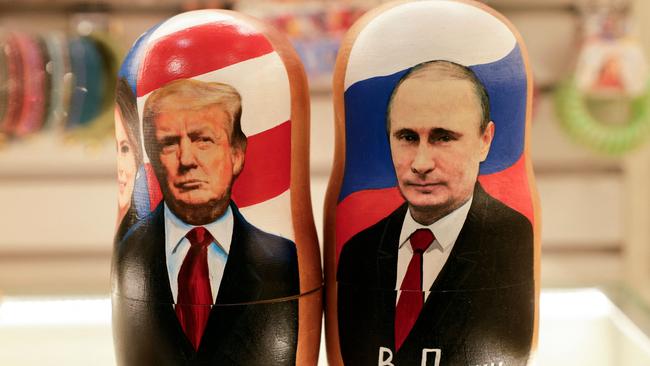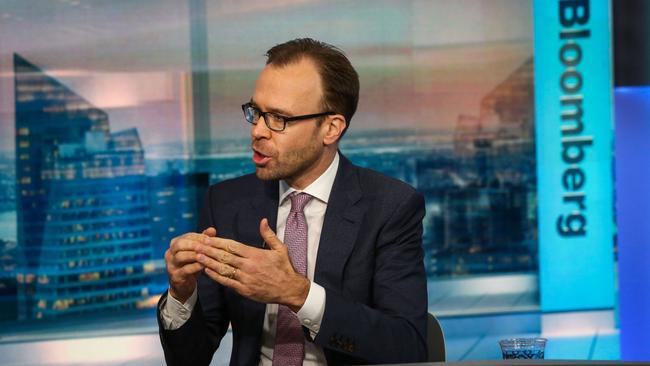Markets brush off trade worries as Trump-Putin talks help sentiment
The US continues to bang the tariff drum but markets are betting a full-scale trade war will be averted, as European stocks soar on growing hopes the Russia-Ukraine war will soon end.

Uncertainty over US trade policy remained high this week as US President Donald Trump announced steel and aluminium tariffs, as well as so-called reciprocal tariffs on its trading partners.
At the same time, the US President started talks with Russian President Vladimir Putin to end the Russia-Ukraine war, pushing European stocks to record highs as European gas prices dived.
Both the Australian dollar and local stock market rose about 0.8 per cent for the week.
The Aussie hit a three-week high of US63.25c and the S&P/ASX 200 hit a record high of 8615.2.
As was the case last week, when 25 per cent tariffs on Canada and Mexico were delayed a month, investors were relieved the new tariffs didn’t start “immediately”, as Trump had said.
The White House has indicated the steel and aluminium tariffs will start on March 12 and reciprocal tariffs will start after a comprehensive review of US trade policy is completed on April 1.
President Trump ordered his staff to develop a “Fair and Reciprocal Plan” for trade, aiming to match other countries’ tariffs, taxes, and non-tariff barriers including regulatory requirements, subsidies, and exchange rate policies. His “Reciprocal Trade and Tariffs” memorandum doesn’t set a hard deadline, but implies the plan would not come before April 1 and no later than August.
While Trump indicated on February 9 a “highly detailed” reciprocal tariff plan would be implemented “almost immediately,” the new Presidential memo calls for the reciprocal plan to be developed only after the Department of Commerce, US Trade Representative and other trade-focused agencies make other policy recommendations to the President on April 1.
The new memo doesn’t set a deadline on the reciprocal plan. Rather, it instructs the White House Office of Management and Budget to submit a report within 180 days (August 12). White House officials described the timeline for the reciprocal tariff plan as a “matter of weeks or months”.
“The long lead time and expansive scope suggest the reciprocal tariff plan might be aimed at negotiation rather than implementation,” said Goldman Sachs chief economist Jan Hatzius.
While Trump has supported a reciprocal plan since his first term and appears serious about equalising tariff rates, the broad scope of his reciprocal tariffs memo is “indicative of a maximalist starting position intended to spur concessions from trading partners, while the long lead-time is likely intended to create room for negotiations,” Mr Hatzius said.
During his announcement, Trump said other countries have already offered to lower certain tariffs.
For now, Goldman Sachs is assuming the US will impose a further 10 percentage point tariff on imports from China, a tariff on “critical imports” like semiconductors and pharmaceuticals, and a tariff on autos from the EU.
But, while not including a broadly-defined reciprocal tariff in his baseline forecasts, Mr Hatzius said Friday’s announcement “raises the possibility that a narrower version could ultimately be implemented for some trading partners later this year”.

Still, the US has so far only implemented a 10 per cent tariff increase on China versus the “day one” tariffs of 50 to 60 per cent or more threatened by Trump in the election campaign.
Gold continues to hit record highs near $US3000 per ounce, so perhaps some investors are hedging their bets, but the market was notably less reactive to trade war escalation this week.
“Tariff ambiguity still reigns, but markets are currently drawing some comfort from the news the next set won’t come into effect before April, thereby instilling some hope they could yet be negotiated away or down,” said NAB head of FX strategy Ray Attrill.
He said the sudden increase in US efforts to end the Russia-Ukraine war this week were “unequivocally positive” for European stocks and currencies against the US dollar.
European natural gas futures fell 13 per cent in the two days after news of peace talks added to a tailwind for European stocks from investors broadening their exposures from the US tech space.
“President Trump’s push for a peace agreement in the Russia-Ukraine war would affect major financial markets mainly through lowering energy prices, especially in Europe,” said Captial Economics deputy chief markets economist Jonas Goltermann.
“In turn, that would be a boost for equities and currencies in the region.
“But, unlike the Russian invasion nearly three years ago, an eventual resolution to the war would probably have a relatively limited overall impact on financial markets, aside from assets directly linked to the Russian and Ukrainian economies.”
So far this month stocks have been resilient to trade wars, sticky inflation and the rise of China’s DeepSeek, but the US market now looks vulnerable to a short-term pullback, according to Goldman Sachs.
“Everyone is in the pool, including retail traders, 401k inflows, start of the year allocations, and corporates,” the US investment bank’s managing director of global markets Scott Rubner.
“The flow demand dynamics are quickly changing, and we are approaching negative seasonals.”
Hedge funds could sell about $US61bn ($97bn) of US stocks over the next month if the market falls, versus only about $US10bn if stocks rise, he said.
US markets will be closed on Monday for Presidents Day.
The Reserve Bank is widely expected to start cutting interest rates after its meeting on Tuesday.






To join the conversation, please log in. Don't have an account? Register
Join the conversation, you are commenting as Logout